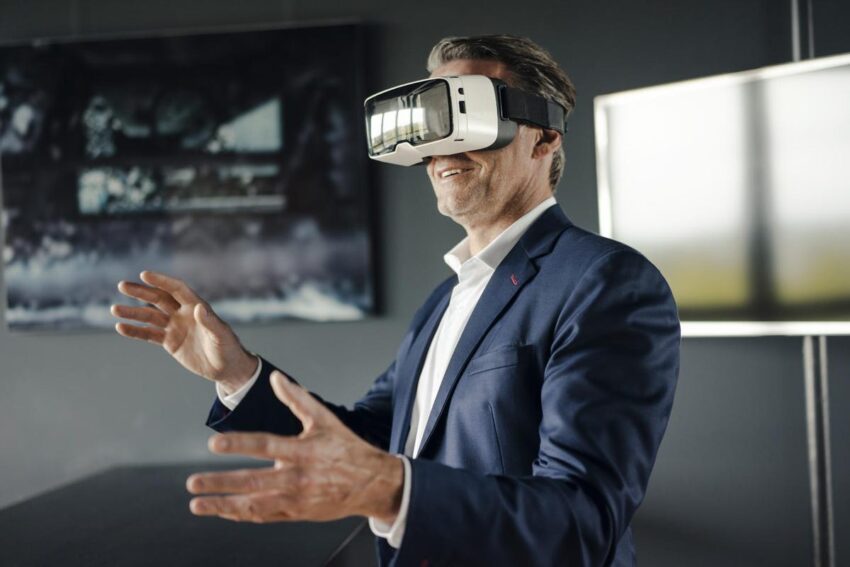Virtual reality is slowly but surely creeping its way into the world of business. It promises to provide the ultimate immersive experience for customers and allow businesses to connect with them in an entirely new way, which can lead to a more satisfying customer experience. From training employees, conducting market research, and improving customer service, virtual reality technology has endless applications in business.
Although virtual reality may still be in its nascent stage of growth, businesses are investing heavily in this technology. Besides using virtual reality technology for business-specific use cases, many companies also utilize virtual reality technology for leisure activities such as gaming and entertainment. If you’re wondering how virtual reality technology will impact your business or if there are ways to implement virtual reality in your organization, read on.
Virtual reality in business

VR technology is quickly evolving into a popular tool for businesses. It has the potential to improve processes and operations in a variety of industries, such as healthcare, real estate, manufacturing, and supply chain. Research shows that the immersive nature of virtual reality can help people experience and learn about environments and situations in a way that’s more effective and engaging than traditional methods. This has led to increased interest in technology among businesses of all sizes.
At present, companies are using virtual reality technologies for a wide range of applications, including product design, training programs, and customer service. For example, virtual reality technologies can be used to create customized training programs or simulate medical procedures. These applications have the potential to revolutionize industries and improve business operations across the board.
How can businesses reap the benefits of virtual reality?
Businesses can use virtual reality (VR) technology to create a computer-generated environment for more impactful meetings, sales presentations, and training.
With the help of VR, businesses can create immersive experiences of their products or services, allowing stakeholders to experience them in real-time and improve safety procedures. This increases productivity and improves customer experience.
VR also helps businesses create customized training programs, improve customer service, and increase sales. This is because businesses can now harness immersive experiences and technology to grow in new ways.
For example, virtual reality can help healthcare professionals understand patient symptoms better by immersing themselves in simulated scenarios of common medical conditions. Thus, businesses can reap the benefits of virtual reality without spending too much money on hardware.
In addition, businesses can leverage VR to prevent accidents and enhance safety processes in industries such as healthcare and pharma.
Different Types of VR Experiences
Virtual reality (VR) is a technology that immerses the user in an artificial environment created with software and presented in a way that the user perceives it as real. This technology has emerged as a promising tool for gaming, simulation, education, and healthcare. The technologies of augmented reality (AR) and mixed reality (MR) have also gained popularity. AR technologies integrate digital elements with the environment in real-time, whereas MR simulates virtual objects within the physical world.
In manufacturing, VR is used to simulate and test the characteristics of machinery, products, and components. Besides, it is also being increasingly utilized for virtual tourism and filmmaking. However, these technologies need high-end hardware to function effectively.
A few years ago when this technology was first introduced in the market, it was associated with high costs and complicated setups. But now you can easily experience virtual reality through your smartphone or PC without spending much money. Higher-end gaming consoles are also now widely available at affordable prices.
What is the Future of VR in Business?
The future of virtual reality (VR) in business is bright. The technology is projected to grow into a multi-billion-dollar industry by 2028, with revenue reaching $50.3 billion. In particular, companies are harnessing the benefits of VR to collaborate and conduct business, with a focus on training simulations and development. Investment in VR & AR is also expected to multiply 21-fold over the next four years, reaching $15.5 billion by 2022. As of now, 54% of larger European companies have a strategy for virtual reality, indicating the booming market for technology.
However, governments must take note of VR’s benefits and potential as well as its limitations before fully embracing it as a tool for business. Aside from the cost of setting up a headset and acquiring necessary equipment (e.g., gaming computers), the technology has many shortcomings that should be considered before investing in it. For example, virtual reality can only recreate reality within limited parameters like gaming or watching videos; simulation cannot replace real-life experience entirely.
Best Practices for Implementing VR in Your Business
Virtual reality (VR) technology is ideal for businesses of all sizes, as it can help them improve safety procedures, increase productivity, create customized training programs, and even improve customer service.
To begin with, businesses can use VR technology to create simulated environments to train their employees on safety procedures. This way, employees can practice these skills in a safe environment before stepping into the real world. Additionally, businesses can use VR technology to create virtual tours for customers. This offers them a glimpse of their product or service without traveling to the actual location. This reduces the occurrence of on-site injuries and keeps visitors safe.
As mentioned earlier, businesses should consider investing in hardware, software, and personnel to make the most of virtual reality applications. When investing in hardware, businesses should invest in high-quality goggles and headsets that are capable of providing an immersive experience. Apartrionrally, they should invest in high-end gaming PCs or laptops so that they can run capable virtual reality games smoothly. Also, businesses should invest in immersive virtual reality software such as 360° video production tools to edit and produce engaging virtual reality content easily.
On the other hand, businesses must invest in skilled personnel who understand how to use virtual reality technologies effectively and safely.
Examples of Successful Virtual Reality Business Strategies
The business potential of virtual reality (VR) is undeniable. Many industries have already adopted VR technologies to create customized training programs, improve customer service, and increase sales. However, the devices were not yet sold in stores when the investment was being made.
With the advent of affordable virtual reality headsets, the virtual reality industry has seen tremendous growth. Now, companies are investing billions of dollars in VR technologies before any devices are officially sold in stores.
This has led to an abundance of new technology and innovation around virtual reality. The gaming industry is one such example of how virtual reality has helped it reach new heights. Gaming generally involves sitting inside a headset for hours on end, but with virtual reality, the experience can be more immersive and engaging than ever before.
Also, the healthcare sector is one area where virtual reality has gained a lot of popularity recently. Virtual reality technology is used in medical simulation training programs to help train healthcare professionals in a realistic environment as it helps them develop critical thinking and problem-solving skills.
Another industry that has embraced virtual reality technology is education. It’s being used to create immersive learning environments for students across various educational institutions, including schools and universities. With its unparalleled capability to immerse users in simulated environments, virtual reality offers the perfect platform for creating engaging and immersive learning experiences that students love.
Conclusion
Virtual reality technology is still in its infancy, but it is expected to revolutionize the way we work and interact with the world around us. From gaming to training simulations, virtual reality offers a new way of experiencing things in a simulated environment. It allows users to experience immersive 360-degree environments that are tailor-made for their use. Technology is already changing the way we work, play, and learn. We hope this primer on virtual reality has helped you get your bearings! Comment below if there is something else you would like to know about virtual reality technology in business.



